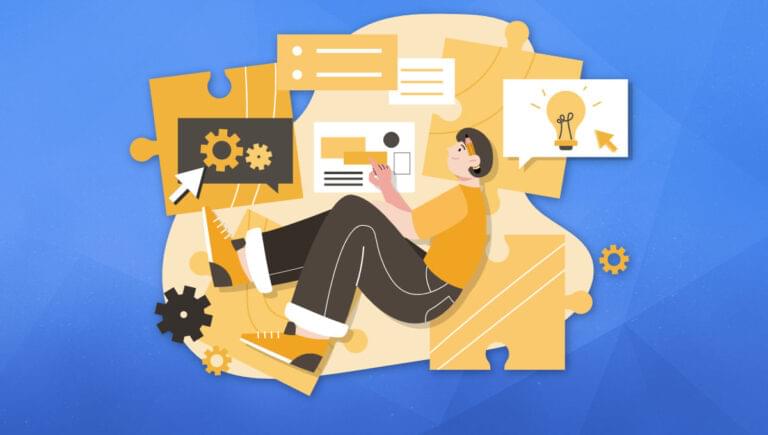Psychology and UX: Decoding the Science Behind User Clicks

In this article, we’ll explore the intricate relationship between psychology and user experience (UX) design, including the profound impact of psychological principles on shaping user behavior. From cognitive processes to emotional influences, we’ll illuminate how understanding user psychology is integral to creating compelling and effective designs.
Key Takeaways
- Understanding User Psychology Is Key: Grasping cognitive processes like perception, attention, and memory is crucial for designing interfaces that guide users toward informed decisions.
- Emotional Design Enhances User Engagement: By leveraging emotional design principles and focusing on positive emotional responses, designers can create more compelling and satisfying user experiences.
- User-Centric Design Principles Drive Accessibility: Prioritizing usability and intuitive navigation ensures that products are accessible and engaging for all users, including those with disabilities.
- Behavioral Design Techniques Influence User Actions: Applying principles from behavioral psychology, such as nudging and the use of scarcity, can encourage users to take desired actions.
- Personalization and User Empowerment Are Crucial: Tailoring experiences to individual preferences and providing users with control options boost engagement and trust.
- Ethical Considerations Are Integral to User-Centric Design: Balancing persuasive design with user autonomy and ensuring informed consent are essential for maintaining trust and ethical standards in UX design.
UX Design and Psychology
UX design is a crucial differentiator for companies seeking to stand out, as it enhances user satisfaction and engagement through improved usability, accessibility, and interaction with the product. By applying principles from psychology to create products that are not only functional but also deeply engaging and impactful, UX designers can create designs that resonate with users on a deeper level.
The intersection of psychology and UX design extends to various design aspects, including user research, information architecture, interaction design, and usability testing.
Understanding User Psychology
Humans often make decisions based on predictable psychological patterns, and this is applicable in the digital world as well. One of the most significant aspects of designing the best user experience is understanding your users well. After all, you’re designing products and experiences for them.
While you can’t literally step into your users’ minds, you can effectively apply user psychology to comprehend how users interact with and perceive your product.
Cognitive processes in user decision-making
Understanding the essentials of cognitive processes allows you to design interfaces, marketing strategies, and user experiences that effectively guide users toward informed decisions. Here’s what a cognitive process involves:
- Perception is how users organize and interpret sensory information from the environment. In the context of UX, while navigating a website, users might perceive a product prominently placed with high-quality images and clear calls-to-action as more important or trustworthy compared to others buried within the content.
- Attention is the selective focus of our mental resources on specific stimuli. In a mobile app, utilizing contrasting colors for important buttons and placing key features above the fold (immediately visible) can attract user attention toward desired actions.
- Memory is the ability to store, retrieve, and utilize information. If a user has had a positive experience with a clear and intuitive layout on a similar platform, they might favor an interface that adopts the same design principles, relying on their memory of past usability, also known as the familiarity principle.
Emotional influences on user behavior
Another important aspect of user psychology in UX design is emotional influences on user behavior that determine how users respond to a design emotionally and how these emotions impact their decisions. Don Norman, the Godfather of UX, in his book Emotional Design: Why We Love (or Hate) Everyday Things, emphasizes that while functionality is essential, it’s emotions that truly seal the deal.
He argues that beyond mere functionality, products that evoke positive emotions, such as pleasure, excitement, or satisfaction, are ultimately more successful in engaging users and building long-lasting positive associations.
For example, if your travel booking website offers users the excitement of browsing through stunning destination photos, the ease of using intuitive filters to find the perfect getaway, and the satisfaction of receiving a confirmation email with a sleek and personalized itinerary. This user journey, created with emotional influence in mind, facilitates feelings of control, trust, and excitement, ultimately influencing your user’s decision to choose your platform for their travel needs.
Conversely, a website cluttered with confusing navigation, hidden fees, and a lengthy checkout process can evoke feelings of frustration and distrust, leading users to abandon the purchase altogether.
Emotional design principles
To create maximum emotional influence on your users, you must leverage emotional design principles to create interfaces that evoke specific emotions in users. These emotions can influence user behavior, build positive associations with the product, and ultimately lead to a more satisfying user experience.
A notable example of this is GEICO Insurance, which has a gecko as its mascot. This playful character instantly grabs every user’s attention, replaces dullness with delight, and subtly increases the likelihood of user engagement due to the positive emotions it evokes.

Here’s how you can apply emotional design and create a more impactful user experience:
- Utilize visual elements. Leverage colors, images, and layout to set the desired mood. For instance, use calming visuals on a banking app to create a sense of security and trust.
- Create micro-interactions. Use subtle animations and feedback sounds to create a sense of delight or satisfaction. For example, use progress bars or celebratory sounds to indicate the completion of a task.
- Make use of storytelling. Use storytelling techniques to engage users emotionally. For example, telling a story about how your product or service has helped other users can create empathy and trust.
- Use humorous messages. Incorporate playful or humorous messages throughout the experience, especially in error messages, to lighten the mood and reduce frustration.
- Leverage social proof. Showcase positive user testimonials and reviews to build trust and credibility, enhancing the emotional connection with your brand.
User-centric Design Principles
User-centeric design (UCD) principles ensure that the design process focuses on creating products and experiences that prioritize the needs, preferences, and behaviors of users. By prioritizing the user throughout the design process, it helps to ensure that the design is intuitive, accessible, and engaging for the target audience.
While user involvement, consistency, and simplicity are at the core of user-centric design principles, here are some more that you must take into account for creating a successful user experience.
Usability and accessibility
Enhancing the usability and accessibility of your products will ensure that they can be used by the widest possible audience, including those with disabilities or limitations. Given that 1.3 billion people globally experience some form of disability, enhancing usability and accessibility presents an opportunity to tap into this vast potential user base.
This involves designing interfaces that are easy to navigate, understand, and interact with, regardless of a user’s background or abilities.
The importance of intuitive navigation
Intuitive navigation is crucial for ensuring that users can easily find and access the information they need within your product. It involves designing menus, links, and other navigation elements in a way that is logical and easy to understand.
It further refines your UX design by helping you:
- Reduce friction. Clear and intuitive navigation minimizes the mental effort users need to find what they’re looking for, reducing frustration and keeping users engaged.
- Improve conversion rates. Intuitive navigation increases the likelihood that users will complete desired actions, such as purchasing a product or subscribing to a service.
- Reduce support costs. By enabling users to find answers independently, intuitive navigation can reduce the need for user support, lowering operational costs.
Inclusive design practices
Inclusive design practices involve designing products and experiences that can be used by people with a wide range of abilities and disabilities. Research has revealed that by accommodating unique needs, you have the potential to expand your customer reach by four times.
Here’s how you can implement inclusive design practices to create products that are more accessible and user-friendly for all.
- Keyboard navigation. Guarantee all functionalities can be accessed using just the keyboard. This caters to users with motor limitations or who rely on screen readers.
- Color contrast. Maintain a clear contrast ratio between text and background colors. This helps users with visual impairments, especially those with color blindness.
- Descriptive text alternatives. Provide alternative text descriptions for images and non-text content. This benefits users who rely on screen readers or have difficulty perceiving visuals.
- Resizable text. Allow users to adjust text size to their preferences. This accommodates users with visual impairments or reading difficulties.
- Subtitles and captions. Include subtitles or captions for video and audio content. This caters to users who are deaf or hard of hearing, as well as those learning a new language.
- Multiple input methods. Consider offering various input options beyond just a mouse or touchscreen. This could include voice commands or gesture controls for users with limited dexterity.
- User testing with diverse groups. Conduct beta testing with a diverse range of participants, including those with disabilities. This allows you to identify and address any accessibility issues early in the development process.
Visual hierarchy and information architecture
Visual hierarchy and information architecture are like the organized sections and labeled shelves in a library. They guide users to find what they need easily, similar to how clear organization helps in a library. These principles work together to:
-
Organize information for user clarity. Think of a recipe book with clear sections for appetizers, main courses, and desserts. Each recipe is organized with a list of ingredients and step-by-step instructions, making it easy for you to follow along. In UX design, organizing information helps users navigate content more efficiently and understand it more effectively. It can be done by using:
- headings and subheadings, which guide users to specific information categories
- bullet points and numbered lists, which make information scannable and easily digestible
- white space, which prevents visual clutter to improve readability
-
Prioritize key elements for effective communication. You might have noticed, while walking into a well-designed store, that the most important products are prominently displayed and highlighted. These key items are strategically placed to catch your attention and communicate their significance.
Similarly, in UX design, prioritizing key elements helps you guide users’ focus toward crucial information, such as important messages, calls-to-action, or essential features, ensuring they’re easily noticed and understood. You can do this by using:
- bold text and larger font sizes, to draw attention to crucial information
- contrasting colors to visually distinguish between different types of content
- call to action buttons, which act as prominent signs directing users to take a specific action, such as “Subscribe” or “Learn More”
Behavioral Design Techniques
Another major strategy that you can implement is behavioral design patterns, which can be used to influence user behavior and encourage specific actions or interactions. These techniques are based on principles from behavioral psychology and behavioral economics, which study how individuals make decisions and behave in various situations.
For example, a shopping website may use the principle of scarcity by displaying limited stock messages (“Only 2 items left!”) to create a sense of urgency and encourage users to make a purchase decision quickly.
Nudging and persuasion
Nudging and persuasion are key aspects of behavioral design techniques that focus on encouraging desired user actions. These techniques aim to subtly guide users towards making specific choices or taking particular actions without restricting their freedom of choice.
According to BJ Fogg, Director of the Stanford Behavior Design Lab, behavior occurs when three variables converge: motivation, ability, and trigger. If behavior doesn’t occur, one of these elements is likely missing.
This model helps designers identify barriers preventing user actions and provides a framework for diagnosing issues, including core motivators, simplicity factors, and prompts or triggers.
Encouraging desired user actions
If you want your users to complete a survey, showing a progress bar can help create a sense of accomplishment and encourage them to finish.
Additionally, going back to Fogg’s model, you can increase user motivation by highlighting the benefits of completing the survey, such as improving future products or services. Enhancing ability can involve simplifying the survey process, making it user-friendly and accessible. Triggers can be employed through timely reminders or notifications, prompting users to engage with the survey.
By combining these elements effectively, UX designers can increase the likelihood of users completing the survey.
Leveraging behavioral economics principles
You can also use behavioral economics principles, such as loss aversion, social proof, and the scarcity effect, to persuade users to take specific actions.
For instance, an ecommerce website may use social proof by displaying customer reviews and ratings to persuade other users to make a purchase. Similarly, showing limited stock messages can create a sense of urgency and persuade users to buy a product sooner.
Gamification in UX
Gamification is another powerful technique to drive user engagement. It’s like sprinkling pixie dust into your user experience, transforming routine tasks into engaging and rewarding experiences. It leverages game mechanics to motivate users, boost engagement, and drive desired behaviors:
-
Apply game elements for enhanced engagement. Incorporating game elements such as progress bars, achievement badges, and virtual rewards can enhance user engagement on a website.
For example, Duolingo, a popular language-learning app, uses a leveling system to track progress and motivate users to continue learning. By gamifying the learning process, users are more likely to stay engaged and motivated to achieve their language learning goals.
-
Motivate user interaction through rewards. Rewards are a powerful motivator in gamification. Offering users rewards for completing tasks or reaching milestones can significantly increase user engagement.
For instance, the Starbucks Rewards program uses a point system where customers earn stars for purchases, which can be redeemed for free drinks or food. This not only incentivizes customers to make more purchases but also creates a sense of loyalty to the brand.
Personalization and User Empowerment
Personalization and user empowerment involve tailoring experiences and providing control options, enhancing user engagement and trust. Netflix is known to build its brand on personalization. Each of its 260.8 million users has a unique home page experience catered to their personal preferences. They are so good at personalized recommendations that they have increased viewer activity driven by recommendations from a mere 2% to a staggering 80%.
By tailoring the experience to each user, you can also create a more meaningful and engaging interaction. Let’s look at some ways this plays out.
Tailoring experiences based on user preferences
Tailoring experiences for your users can significantly improve their satisfaction and engagement with your product or service. This not only enhances the user’s experience but also promotes a sense of connection and loyalty to your brand.
By leveraging user data and behavior, you can:
- Recommend relevant content and features. Show users products they’re likely to be interested in, suggest articles based on their reading history, or personalize search results based on past queries.
- Adapt the interface. Adjust the layout, language, or even the color scheme based on user preferences, creating a more comfortable and familiar experience.
- Offer personalized communication. Tailor email newsletters, marketing messages, or in-app notifications to resonate with individual users.
Providing control and customization options
Empowerment goes beyond simply tailoring the experience. It’s about giving users control over their interaction. This can include:
- Customization options. Allow users to personalize their dashboard, set preferences, or choose how they want to interact with the product.
- Transparency and control over data. Communicate how user data is collected and used, and provide options for users to manage their privacy settings.
- Multiple pathways to accomplish tasks. Offer alternative ways to achieve the same goal, catering to different user preferences and learning styles.
Build trust through transparent personalization
Building trust is crucial for successful personalization. Users need to feel comfortable with how their data is used and confident that their preferences are respected. Here’s how to achieve that:
- Be transparent about data collection and usage. Clearly explain what data is collected, how it’s used, and who has access to it.
- Offer clear opt-out options. Allow users to choose whether or not they want their data to be used for personalization.
- Focus on the benefits. Communicate effectively how personalization enhances the user experience and provides value to them.
Case Studies: Effective UX Strategies
A successful UX design strategy is one that effectively meets the needs and expectations of users while aligning with the goals of the business or organization. Here are some examples of companies that have successfully implemented UX design strategies that leverage the power of psychology to enhance user experience.
Amazon’s one-click ordering
Amazon implements Loss Aversion — a behavioral economics principle — in its one-click ordering system. This system reduces the perceived effort of making a purchase, leveraging the psychological tendency of users to be more likely to complete a purchase when they perceive they might miss out on a product if they don’t act quickly.
LinkedIn’s profile strength meter
LinkedIn’s profile strength meter leverages Hull’s Goal Gradient Effect, where people are motivated to complete a goal (in this case, filling out their profile) as they perceive themselves to be closer to the end. UX designers leverage this effect to increase user engagement and completion rates.
Apple’s minimalist design
Apple’s minimalist design across its products suggests the use of Sweller’s Cognitive Load Theory, which implies that humans have a limited capacity for processing information.
By minimizing clutter and unnecessary elements, Apple reduces cognitive load, making it easier for users to focus on essential elements and engage more deeply with the core features and functionalities of its products.
Case Studies: Ineffective UX Strategies
Here are some interesting instances where companies implemented UX design strategies that didn’t resonate with users, along with the insights gained.
Snapchat’s app redesign
In 2018, Snapchat redesigned its app to separate content from friends and content from publishers, aiming to increase user engagement. However, the redesign led to a significant backlash from users who found the new layout confusing and less intuitive. This resulted in a loss of users and a decline in user engagement.
Learning: avoid drastic redesign and follow Weber’s law, which suggests that the just-noticeable difference between two stimuli is proportional to the magnitude of the stimuli. In UX design, this means that gradual, incremental changes are often more effective and better received by users than sudden, drastic redesigns.
Google+ auto subscription
In 2011, Google+ automatically subscribed users to the Google+ profiles of their Gmail contacts, a strategy seen as intrusive and violating user privacy. This lack of transparency, coupled with the failure to address security bugs that compromised user privacy, led to widespread negative press and user complaints, ultimately contributing to the platform’s failure and shutdown in 2019.
Learning: uphold user autonomy and privacy by transparently communicating data practices. Provide users with control over their information and preferences to promote customer loyalty and mitigate backlash.
Airbnb “Trips” feature
In 2016, Airbnb launched “Trips”, a feature aiming to be a one-stop shop for booking various travel experiences alongside accommodation. However, users found the interface cluttered and confusing, and the feature failed to gain traction.
Learning: always ensure to perform user testing and check whether a new feature aligns with existing user behavior. Thoroughly understand user needs and behavior before introducing new features. Also, present information in chunks following Miller’s law, which suggests breaking down or organizing different kinds of information into manageable chunks (around 7 plus or minus 2) to help users easily navigate and process the information they see, improving overall user experience.
Testing and Iteration in UX Design
Testing and iteration are crucial components of the UX design process, ensuring that design elements are user-centric and effective. By engaging users early and often, you can gain invaluable insights into how users interact with your creations, understand their needs and pain points, and identify areas for improvement.
For instance, Spotify regularly tests new features with a subset of its users before rolling them out to everyone. This iterative approach allows Spotify to gather feedback, refine the features, and ultimately provide a better user experience.
Importance of user testing in validating design choices
User testing is crucial for validating your design assumptions before they become costly mistakes. Imagine spending months developing a feature only to discover later that users find it confusing or useless. User testing helps you avoid this pitfall by helping you:
- Identify usability issues. Observing user interactions uncovers problems like unclear labels, confusing navigation, or clunky workflows. For example, a user testing session might reveal that users struggle to locate the search bar due to its poor placement or lack of visual prominence.
- Evaluate user understanding. Testing assesses if users comprehend the design’s purpose and functionality. For instance, it might show users don’t understand key product features due to unclear benefit statements or missing information.
- Gauge user satisfaction. Testing allows you to measure user satisfaction with your design by collecting feedback. For example, users might express frustration with slow loading times during a mobile app test.
Incorporating user feedback for iterative improvements
By collecting user feedback, you can easily identify areas for improvement and make iterative changes to enhance the user experience. You can collect feedback through surveys offered by customer experience software tools, conduct interviews, or perform usability testing.
Here’s how collecting user feedback works for iterative improvements:
- Identify pain points. Through interviews, surveys, and usability testing, you can uncover users’ pain points and frustrations with your existing design. For example, feedback might reveal that users find the checkout process of an ecommerce website lengthy and cumbersome.
- Prioritize improvements. Based on user feedback, you can prioritize which aspects of your design need the most attention. This ensures your efforts are focused on addressing the issues that matter most to users. For example, based on feedback, the ecommerce website team might prioritize streamlining the checkout process by reducing unnecessary steps and offering guest checkout options.
- Refine your design. User feedback guides you in refining your design and making it more user-friendly and intuitive. This iterative process leads to a design that truly resonates with users and addresses their needs effectively.
A/B testing for optimization
A/B testing involves comparing two different versions of a design element and identifying which one performs better based on user behavior. It allows you to make data-driven decisions for further optimization.
For example, a news website might A/B test two different versions of its home page layout — one emphasizing breaking news, the other curated content — to see which keeps users on the site longer and drives more page views.
Here are some reasons why you should consider performing A/B Testing for optimization in your design systems.
- Test specific design variations. A/B testing compares different versions of elements like buttons, CTAs, layouts, or even entire pages to test hypotheses and determine which is more effective. For example, testing two different color variations for a Buy Now button to see which drives more conversions.
- Obtain quantifiable results. A/B testing provides you with quantitative data on user behavior, such as click-through rates, conversion rates, and time spent on a page, helping you objectively choose the best design. For instance, if a red Buy Now button gets more clicks than a blue one, this suggests it’s more visually appealing and encourages users to take action.
- Continuous optimization. A/B testing allows you to continuously refine and optimize your design based on data-driven insights. After implementing the red Buy Now button, you can conduct further A/B tests to optimize other elements of the website, like product descriptions or promotional banners.
Ethical Considerations for User-centric UX Design
While user-centricity remains paramount in UX design, it’s crucial to approach it with ethical considerations in mind. Our design decisions have the potential to influence user behavior and well-being, and neglecting ethical principles can have detrimental consequences.
Here are some key areas to consider:
- Balance persuasion with user autonomy. As a UX designer, you would aim to persuade users to take specific actions, such as making a purchase or signing up for a service. However, it’s essential to respect user autonomy and avoid manipulative tactics that may coerce users into actions they’re not comfortable with. Providing clear information and choices empowers users to make decisions aligned with their preferences.
- Ensure informed consent in UX design. Obtaining informed consent is crucial, especially when collecting personal data or implementing features that may impact user privacy. You should clearly communicate the purpose of data collection, how the data will be used, and provide users with the option to consent or opt out.
- Move beyond legalese. Instead of relying on complex legal jargon, present privacy policies in clear, concise language that avoids ambiguity. Users should be able to understand what they are consenting to without needing legal expertise.
- Address privacy concerns and data security. When you prioritize secure data storage, encryption, and compliance with privacy regulations and communicate it transparently to your users, you build trust among your users while ensuring ethical practices.
Future Trends in UX Design
The ever-evolving landscape of UX design is brimming with possibilities. By embracing emerging technologies and delving deeper into the complexities of human behavior, designers can create experiences that not only meet user needs but also resonate with them on an emotional level.
This human-centered approach has the potential to revolutionize the way we interact with technology and shape the future of user experience.
Emerging technologies in UX design
Here’s what is shaping the future of UX:
Augmented reality (AR) and virtual reality (VR). These immersive technologies necessitate understanding user perception, spatial awareness, and emotional responses within virtual environments. Designing for AR/VR will require adapting psychological principles to ensure user comfort and engagement, and to prevent extraneous cognitive load.
Artificial intelligence (AI) and machine learning (ML). AI-powered personalization will require careful consideration of user biases, ethical implications, and potential for discrimination. Understanding user psychology will be crucial in ensuring AI personalizes experiences responsibly and fairly.
Voice user interface (VUI). Designing for VUIs like Amazon Alexa and Google Assistant requires understanding speech recognition, natural language processing, and user intent. It’s crucial to grasp how users interact with VUIs and their expectations for voice interactions to create intuitive experiences.
The evolution of psychology-driven UX strategies
Over the years, UX design has undergone a fascinating transformation. While the initial focus lay on aesthetics and usability, a paradigm shift has emerged, placing psychology at the forefront of creating exceptional user experiences. This shift has led to several key trends shaping the future of UX design, including:
- Focus on emotional design. There will be a stronger emphasis on designing based on users’ emotional journeys, aiming to evoke positive feelings and build trust with users.
- Neuroscience and biometric research. Advances in these fields will offer deeper insights into user behavior, leading to more intuitive interfaces that adapt to users’ cognitive states.
- Hyper-personalized experiences. Leveraging psychology and new technologies, UX design will create experiences tailored to individual needs and preferences, increasing user satisfaction.
- Increased human–computer interaction. As technology becomes more intuitive, interactions will feel more natural and seamless, blurring the lines between physical and digital worlds.
Conclusion
The intersection of psychology and UX design has transformed the way we approach user experience. By understanding and applying psychological principles, designers can create more engaging, intuitive, and impactful experiences for users. From cognitive processes to emotional influences, psychology plays a crucial role in shaping user behavior and driving design decisions.
As we look to the future, emerging technologies like AR/VR, AI/ML, and VUIs will continue to shape digital UX design, offering new opportunities to create innovative and personalized experiences. By embracing these trends and continuing to focus on psychology-driven strategies, designers can create experiences that not only meet user needs but also resonate with them on a deeper level, ultimately shaping the future of user experience.
Tanya is the Digital Marketing Manager at Zonka Feedback, a leading customer feedback and experience management company. With a keen eye for trends and a passion for technology, Tanya navigates the digital landscape with finesse, driving impactful strategies to enhance brand presence and customer engagement.

Published in
·APIs·Design Patterns·Libraries·Patterns & Practices·Performance·Performance & Scaling·PHP·Web Services·September 12, 2016




